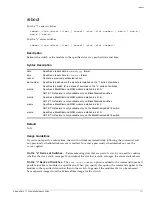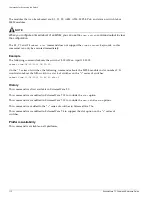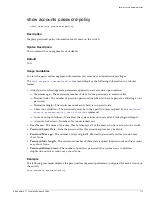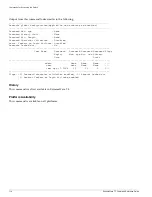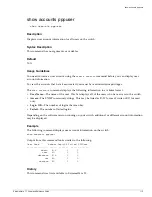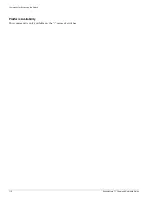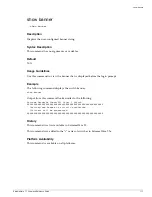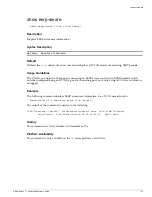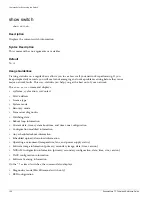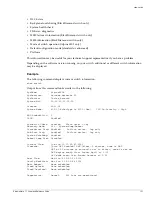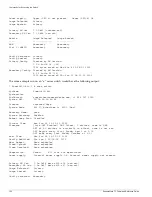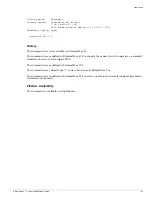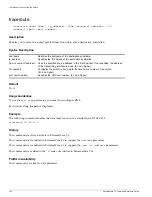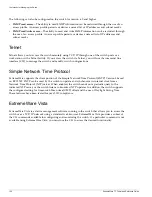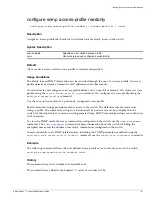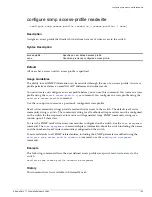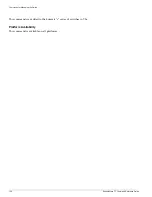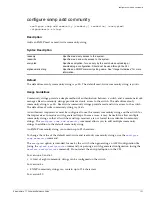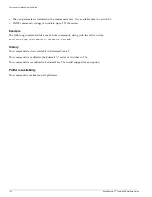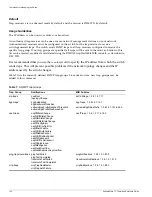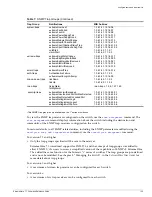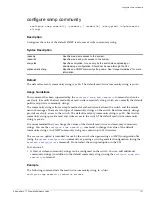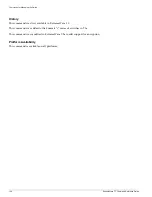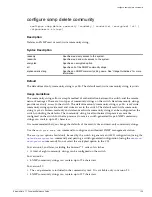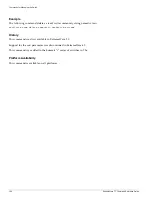
ExtremeWare 7.7 Command Reference Guide
125
3
Commands for Managing the Switch
This chapter describes:
•
Commands for configuring Simple Network Management Protocol (SNMP) parameters on the
switch
•
Commands for managing the switch using Telnet and web access
•
Commands for configuring Simple Network Time Protocol (SNTP) parameters on the switch
SNMP
Any network manager running the Simple Network Management Protocol (SNMP) can manage the
switch, if the Management Information Base (MIB) is installed correctly on the management station.
Each network manager provides its own user interface to the management facilities.
The following SNMP parameters can be configured on the switch:
• Authorized trap receivers
—An authorized trap receiver can be one or more network management
stations on your network. The switch sends SNMP traps to all trap receivers. Entries in this list can
be created, modified, and deleted using the RMON2 trapDestTable MIB variable, as described in
RFC 2021.
• Authorized managers
—An authorized manager can be either a single network management station,
or a range of addresses (for example, a complete subnet) specified by a prefix and a mask. The
switch can have a maximum of eight authorized managers.
• Community strings
—The community strings allow a simple method of authentication between the
switch and the remote Network Manager. The default read-only community string is
public
. The
default read-write community string is
private
. The community strings for all authorized trap
receivers must be configured on the switch for the trap receiver to receive switch-generated traps.
• System contact (optional)
—The system contact is a text field that enables you to enter the name of
the person(s) responsible for managing the switch.
• System name
—The system name is the name that you have assigned to this switch. The default
name is the model name of the switch (for example, Summit1).
• System location (optional)
—Using the system location field, you can enter an optional location for
this switch.
Summary of Contents for ExtremeWare 7.7
Page 60: ...60 ExtremeWare 7 7 Command Reference Guide Contents ...
Page 72: ...72 ExtremeWare 7 7 Command Reference Guide Command Reference Overview ...
Page 404: ...404 ExtremeWare 7 7 Command Reference Guide VLAN Commands ...
Page 472: ...472 ExtremeWare 7 7 Command Reference Guide QoS Commands ...
Page 492: ...492 ExtremeWare 7 7 Command Reference Guide NAT Commands ...
Page 890: ...890 ExtremeWare 7 7 Command Reference Guide Security Commands ...
Page 1130: ...1130 ExtremeWare 7 7 Command Reference Guide Security Commands ...
Page 1164: ...1164 ExtremeWare 7 7 Command Reference Guide Configuration and Image Commands ...
Page 1436: ...1436 ExtremeWare 7 7 Command Reference Guide Wireless Commands ...
Page 1490: ...1490 ExtremeWare 7 7 Command Reference Guide EAPS Commands ...
Page 1576: ...1576 ExtremeWare 7 7 Command Reference Guide ESRP Commands ...
Page 1774: ...1774 ExtremeWare 7 7 Command Reference Guide IP Unicast Commands ...
Page 1914: ...1914 ExtremeWare 7 7 Command Reference Guide IGP Commands ...
Page 2000: ...2000 ExtremeWare 7 7 Command Reference Guide BGP Commands i Series Switches Only ...
Page 2140: ...2140 ExtremeWare 7 7 Command Reference Guide IPX Commands i Series Platforms Only ...
Page 2156: ...2156 ExtremeWare 7 7 Command Reference Guide ARM Commands BlackDiamond Switch Only ...
Page 2168: ...2168 ExtremeWare 7 7 Command Reference Guide Remote Connect Commands ...
Page 2346: ...2346 ExtremeWare 7 7 Command Reference Guide PoS Commands BlackDiamond Switch Only ...
Page 2446: ...2446 ExtremeWare 7 7 Command Reference Guide LLDP Commands ...
Page 2496: ...2496 ExtremeWare 7 7 Command Reference Guide H VPLS Commands BlackDiamond Switch Only ...
Page 2620: ...2620 ExtremeWare 7 7 Command Reference Guide Index of Commands ...

